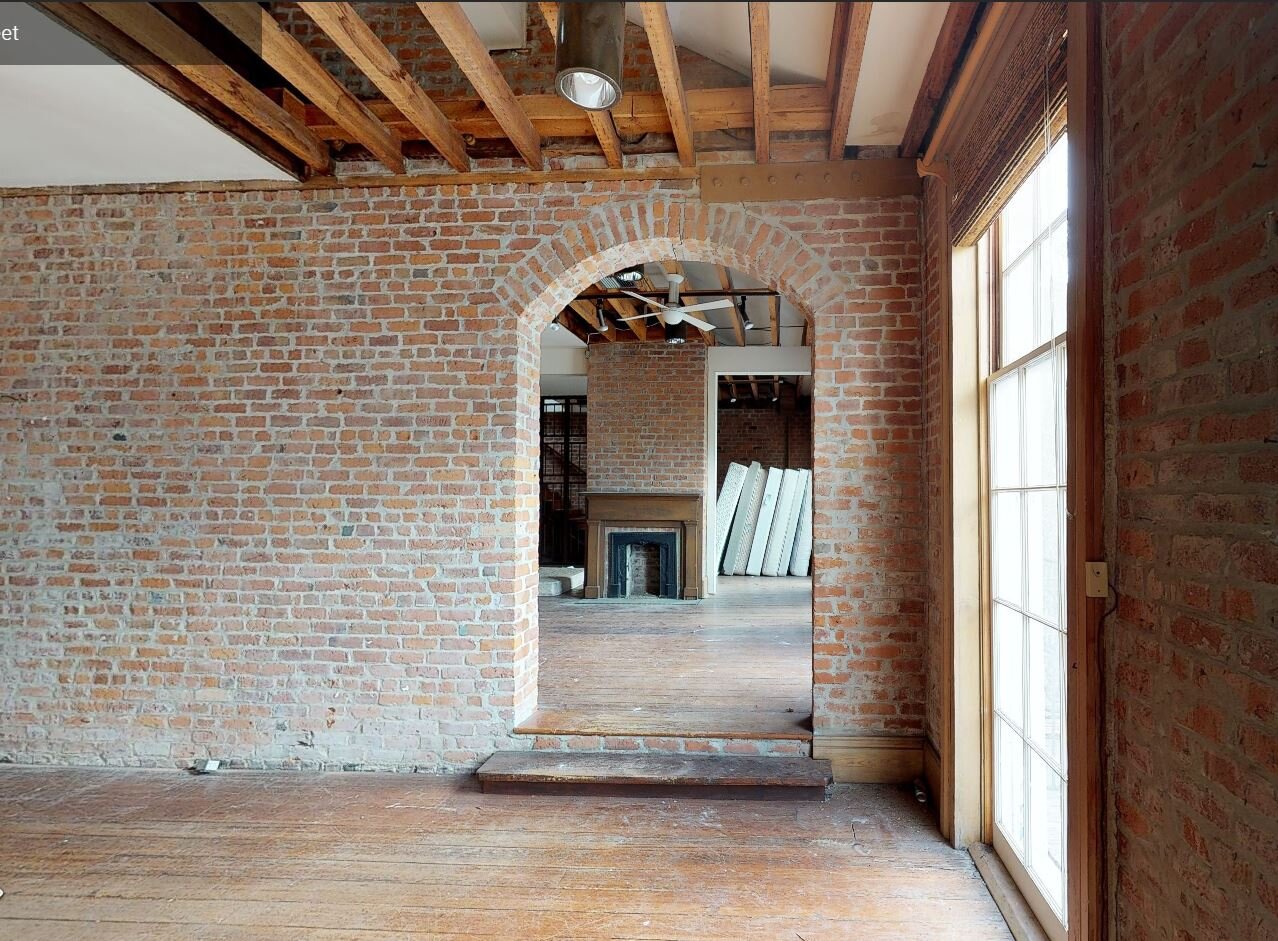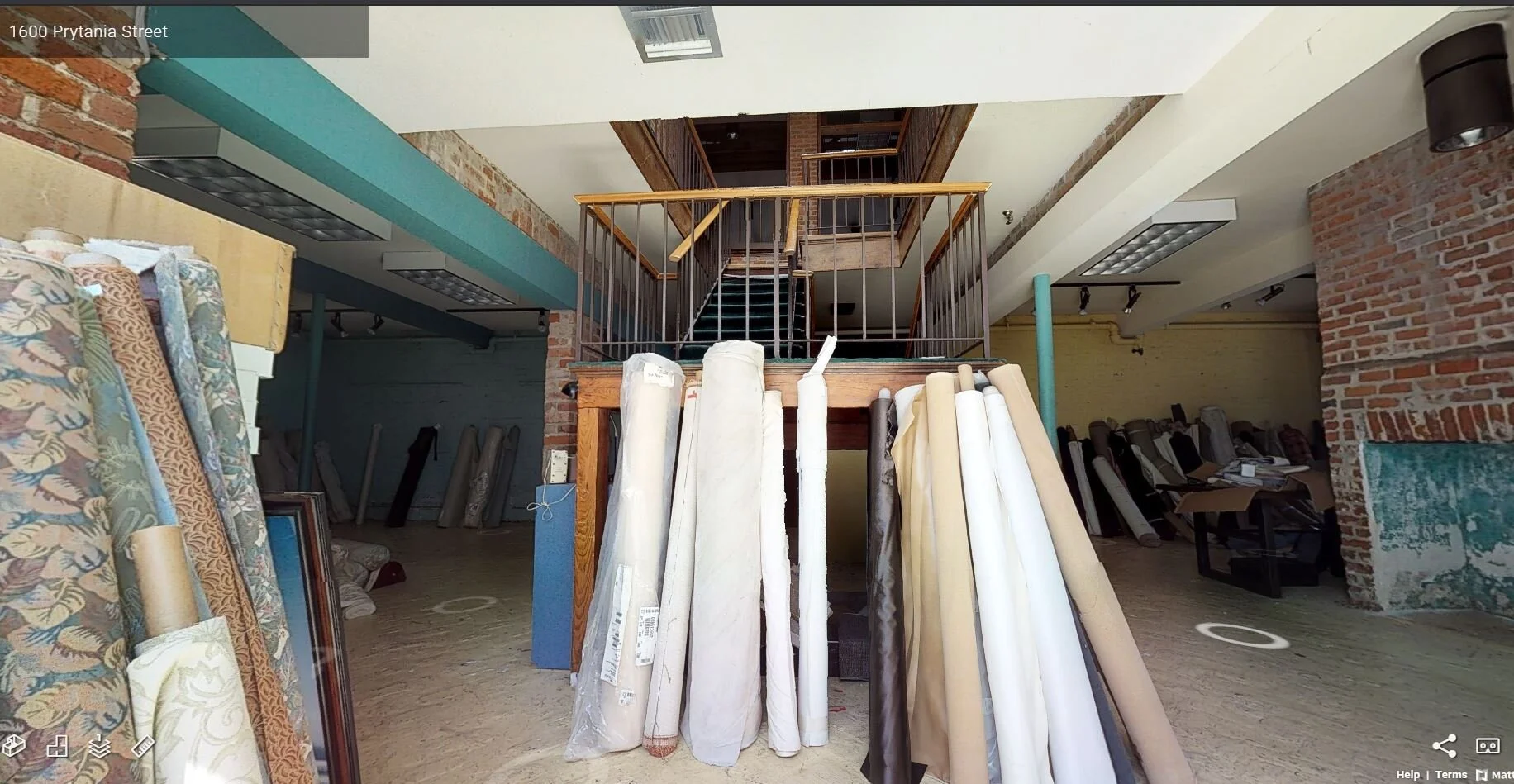Our goal for this blog post is to help guide frantic property owners on the ins-and-outs of the HDLC permitting process. We have completed several projects that are in both partial and full control districts, and each time the process has been a little different. On top of that, the COVID-19 pandemic has changed things how things worked as well. We’ll try to keep this post as short and sweet as possible - though there’s a lot of information to process.
We’ve included links to various sources that can help property owners understand what they can expect in the months leading up to approval from our perspective. We will also touch on our projects that required Certificates of Appropriateness from the HDLC for reference.
Example Project: Partial Control Camelback
Camp Street Camelback, Uptown District: We removed the farthest back historic room for the conversion. This did not trigger any commission approvals, as in a partial control district we stayed well below the roof and wall removal thresholds, and did not touch the front facade.
Resources
Preservation Resource Center - Navigating HDLC: We are going to hit some points that the PRC did not hit in their presentation. Just so there is not overlapping information. You can click the here to see that presentation.
Identifying New Orleans Architectural Styles: If you don’t know the style of your property, refer to this page.
Example Project: Partial Control Attic Build-Out
Black Pearl Creole, Carrollton District: This structural renovation did trigger the roof demolition rule, as the owner wanted to remove the historic roof and replace with a new roof with dormers. Because the new roof pitch did not match the existing roof pitch, this is not seen as a “replacement-in-kind”, therefore must be reviewed by the Commission at a council hearing. It was approved.
Getting Started
Let’s assume you are aware of your property’s status in a historic district. Your first question may be “what can I do?” or “what can I NOT do?” these are always our first question from clients. Most experienced NOLA-based architects will be able to answer these basic and broad questions regarding your renovation or addition. The answers and approval timeline looks different depending on your district. You can refer to this page for information pertaining to which district types you are in: full or partial control.
Do your renovation plans trigger a review by the board? If you answer is yes to ANY of the questions below, you will need to get approval by the HDLC board at a commission hearing.
Partial Control District Triggers:
The structural removal, obscuration, or increase in height of any exterior wall altering more than 50% of the total exterior structure, or the restructuring of more than 50% of the structure’s exterior wall area
The removal, alteration, or obscuration of more than 50% of the existing roof structure measured in plan view
The removal, alteration, or obscuration of more than 25% of the historic materials, as determined by HDLC staff, on the primary façade; or
The raising of an existing building to create habitable space that complies with the ceiling height requirements set forth in Sec. 26-196.
Full Control District Oversight:
Building Rating: The PRC touches on this in their presentation, but basically you need to know whether your property is an S or C or N property: Significant, Contributing or Non-contributing property.
Guidelines for New Construction, Additions and Demolitions.
Levels of Review: If you plan to deviate from any of the guidelines above you will need to get approval from HDLC. The Staff level person or the ARC (Architectural Review Committee) will review this prior to the HDLC hearing and make a recommendation to the HDLC whether to approve or deny the appeal.
Obscuration means concealing, hiding, encapsulating, or covering a building’s exterior walls, existing roof structure, or historic materials on primary facade in whole or in a significant part with new or replaced elements.
Example Project: Partial Control Addition
Austerlitz Addition, Uptown District: Here we did propose to alter the front façade, but not enough to trigger any commission reviews. This project was approved at the STAFF level.
Application Process
Once you have a general idea of your project goals, you can work with an architect or a design professional to illustrate the changes that will be proposed in the application process.
Depending on how much work you are doing to the property, you will need to submit an application for permit which comes in the form of various degrees of work from non-structural renovation to structural renovation to new construction. Every application is reviewed by City of New Orleans planners. The application can be filled out online by accessing this portal, creating a user name and password and clicking on the corresponding link under the “PERMIT - BUILDING” section on the left hand side of the webpage. We typically do this portion of work for our clients.
Your address will be one of the items required in the application and that will determine which staff person at the HDLC will review the application for compliance. If you are in a partial control district and you do not trigger any of the demolition rules, the staff person will clear the application and pass it onto the zoning and planning departments. If you are in the full control district, you might be required to meet with the ARC (architectural review committee). From there, they will either approved your design or defer the proposed design to the HDLC with a recommendation.
You will be required to provide at minimum a plan and elevation with building heights and dimensions. You may also be required to provide renderings. Renderings provide a perspective of the property and will illustrate what elements will be seen from the street view.
Deadlines for ARC submissions are generally due 3 weeks prior to the actual meeting, same for HDLC. So give yourself enough time to complete your presentation. A list of the meetings can be found here.
Example Project: Full Control Renovation
Chippewa Renovation, Irish Channel District: This change was reviewed by the ARC in a hearing because we proposed modifications that altered the existing historic exterior in a FULL control district. The porch addition was approved but the dormers were not. Some minor exterior details were worked out at STAFF level during the construction process.
Council Meetings
Council meetings are now held virtually, whereas before the pandemic, they were held in City Hall chambers. Each project is assigned a slot on the agenda. An HDLC staff person will introduce the project to the council, and you are allowed to make a statement about your project and then a determination was given. Right now, you must make your statement online (to be read out loud) at the meeting, instead of speaking in person - and you are asked to remain muted unless your project is being presented. Honestly, I don’t hate this new virtual process. Instead of travelling to City Hall and sitting in the chambers quietly until our project was presented, we now can sign on mid-meeting in the comfort of our office or home.
Still Have Questions
If you still have questions and are feeling lost in this process, it may be wise to reach out to an architect or a design professional, or just contact one of the staff people at the HDLC office. I hope we provided enough examples of work that might help you gauge the complexity of the application process. As always, reach out if you want to learn more and how we might be abke to help!
Establishing "Multifamily" for the Better

What makes New Orleans neighborhoods so great is the same things that make neighborhoods great around the world: variety.
While most of the country was busy zoning their neighborhoods into single-use enclaves of uniformity, New Orleans, as it does, was busy ignoring national urban planning trends and standards. In this case, it was a good call.
As a result, we have retained our multi-use, finer-grained urban fabric of building use and type, and have reaped the benefits, being a top choice to live, work and vacation for humans in general.
Read MoreSalvaged Architecture
Just because you are doing a gut renovation or constructing new, doesn’t mean you can’t incorporate salvaged materials. Trending or not, this design strategy has many benefits from the sustainable reuse of resources to getting a custom look for less. Applications of old elements with new construction are by nature unique to each project and will have many of your friends awed by your creativity!
Read MoreSchematic Design Strategies for Historic Properties

In New Orleans, we have over 20 nationally-registered historic districts and 19 local historic districts. Any effort developing concepts in the planning phase needs to address the historic context of the neighborhood. The façade of the home does not only belong to the owner but it belongs to the city, to the neighborhood, and to the lovers of historic architecture who come from all over the world to New Orleans.
Read MoreLizardi Town Homes: a Perspective from the Architects
I wanted to blog about our latest completed project: the Lizardi Town Homes, as an opportunity to showcase some of our beautiful before-and-after photographs, but there is so much to cover, or uncover rather, with this project. Everything from the history of the building, to the owner’s discovery of the space, to our strategy in telling it's story through architecture.
Corner of Prytania and Terpsicore - BEFORE
Corner of Prytania and Terpsicore - AFTER
Growing up in New Orleans, I have always had an appreciation for the historic building stock, the layers of history and how each generation adapts these buildings to their interpretation of "modern".
The Lizardi Town Homes were built around 1836. Historians discovered that like many of the homes along the Mississippi River in New Orleans, the property was once a part of a larger plantation or estate. Eventually parceled off because of the economical pressures of downtown expansion and farming opportunities in more rural settings.
Sanborn Map showing the Lizardi Trio Town Houses
The original structures, three total at their conception, were built for the Lizardi Brothers, who were Mexican trade merchants using New Orleans as their pit stop while traveling back and forth from Mexico to Europe. Henry Laurence bought the property in 1847 and kept the property the longest until around 1970 when the property was purchased by a furniture retailer/fabricator. At this point in history, the buildings were modified into a large, single-occupancy space. At some point in history, the smallest building of the trio was demolished and the vacant lot used for parking.
The buildings’ newest owner is our client, Developer Montgomery Berman and Co.. He discovered the town homes in their most “modern" configuration with an atrium in the back. This atrium connected the once "service wings" of the main structures with a stylized, wood-and-glass curtain wall.
Walking through the building for the first time, we could see that this addition may have be installed around the 1970’s or 1980’s, when the furniture store was expanding their showroom and offices. The wood windows lacked proper flashing and were beginning to rot, and the minimal amount of new finishes applied to the atrium space were dated and lackluster. Original brick paving at the ground level remained, but was painted to match the walls.
BEFORE: our client found the buildings with a two-story stair atrium enclosed with a stylized, wood-and-glass curtain wall.
BEFORE: interior views of the atrium space that was added around the 1970s or 1980s.
The main structures, now connected through brick archways, were stripped down, bare and dark. Instantly, I could visualize the Lizardi or Laurence family enjoying these rooms with their large, double-hung windows and wrap around balconies. I could see hoop-skirts, gas lanterns, and depression china. I could hear piano melodies and brass ensembles. One of the original stairs was still there, the heart pine winders and iron railing were a tactile glimpse into the past.
BEFORE: connected main structures
AFTER: bedroom space for one of the apartments
Our Design Strategy
With the developers approval, we proposed removing the 1970’s additions. The atrium enclosure was hiding the historic service wings. Below the service wings' balconies, we didn’t simply fill the large openings on the first floor with stucco-clad wall to match, but rather diagonal cedar planks as a gesture to the story of its modified past.
BEFORE: atrium addition circa 1970
AFTER: courtyard between original service wings
Although the original kitchens and washrooms would have been on the first floor in the service wings, our new program called for kitchen and bathrooms in the main structures. The buildings' new program required more tenant occupancy, thus resulting in four kitchens total instead of two.
One of the design strategies we used called for was modern delineation: sharp, white lines against antique brick walls. This contrast highlighted what is new and what is old. Smooth sheetrock walls abutting rough brick walls can create odd details so we painted the return side of sheetrock bead black, so that the planes appeared flush and intentional.
Original Wood lintels and transoms above historic openings were retained and repaired.
The only original door found on the property was used as a basis of design for many new doors.
Fresh coats of paint on the exterior stucco facade and gas lanterns dotting the entrances enliven the buildings' street presence. The modern railing in the courtyard was an intentional choice due to the fact that original service wing railings were shorter with balustrades further spaced apart. Fabricating these railings back to historic proportions would have been a safety concern and code issue. Instead of designing a traditional wood railing, we chose to use cable rail. Cable rail allows views to penetrate further and focus on the architecture instead of tightly space white balustrades creating visual clutter.
We chose colorful cabinets and brass accents in the kitchens. The bold colors nodding to the colorful timeline of the buildings’ history and brass complimenting the warm of the space. We tried to minimize exposed electrical conduit were we could. With exposed brick walls everywhere, we had to run electrical wires in the baseboards, so that silvery conduits were not popping up like gophers along the historic walls.
Corner Apartment - BEFORE
Corner Apartment - AFTER
With over 1,000 unique conditions, this project, for us, required constant eyes in the field. That is the difference between restoration and renovation; the difference between preservation and remodeling. What remained, untouched and creating character in the space, was left alone. What we could build back, windows and doors in particular, we did to the proportions of the original structure. We let history inform the product, in this case. We used our filter to create the story.
Project Team: Developer: Montgomery Berman & Co., Architects: Studio BKA, LLC, Contractor: NFT Group

















